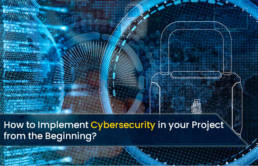In the contemporary era of rapid technological advancements, adequate cybersecurity has become a more significant necessity than ever before.
While the technologies including, IoT, AI and ML, continued to evolve on one side, cyberattacks continued to emerge on the other side.
Cyber-crime is continuously on the rise, with virtually all business firms irrespective of size exposed to cybersecurity risks.
According to Accenture’s global survey, cybersecurity breaches have increased by 67% over the past five years.
These staggering cybersecurity statistics have brought ‘Cyber Security’ to the forefront in most organizations.
As inadequate security network may leave the company vulnerable to malicious attacks, the tech leaders are striving to build security into their products and services from the very beginning of a project.
Implementing security from the start and continuing it throughout the development cycle is an industry best strategy to prevent and protect from cyberattacks.
However, the process is tedious and requires detailed planning before execution.
At this very juncture, we bring you the best ways a tech leader can adopt to address cybersecurity from the start of the tech project.
ALSO READ: Cybersecurity Tips for Small Business
Steps to Implement Cybersecurity in Your Technology Project

1) Define Clear Boundaries
Define the information system’s boundaries clearly. Apart from identifying where the data is stored, you must determine where the data flows, as well as the critical dependencies.
With the defined system boundary, the organization should have a clear and well-defined representation of all entities that store or process system data. For instance, getters and setters in software development clearly define the boundaries of data stored or processed by your product.
2) Deter Insider Threats
According to the cybersecurity statistics, the majority of the cyberattacks occur from within and result from employees who have access to confidential data.
34% of cyberattacks in 2019 originated with internal actors (Source: Verizon)
You have to foster a culture of vigilance in all the employees to keep your company safe.
3) Security Awareness Training
Even if you have the best security policy in place, it’s imperative to ensure that every employee understands cybersecurity and its importance in the present perilous world.
Ensure that employees know that cybersecurity is a top priority and understand the comprehensive initiatives and procedures you have in place to protect from cyber threats.
Regularly implement security awareness training programs for your employees to understand the concepts of spam, phishing, spear-phishing, malware, and ransomware. Encourage employees to follow the necessary security policies and consider security as a fundamental work consideration.
Global spending on ‘Security Awareness Training’ for employees is expected to attain USD 10 billion by 2027, up from around USD 1 billion in 2014.
ALSO READ: Top 5 Cybersecurity ‘Trends’ to Watch in 2020
4) Network Segmentation
Network segmentation is an essential and highly effective security measure an organization can implement when building a new product architecture.
Network segmentation involves dividing a more extensive computer network into several small subnetworks that are isolated from each other to improve network security.
When building a new architecture, think of security implemented at the beginning. A well-segmented network limits the impact of network intrusions, prevents breaches, reduces their scope, and increases overall data security.
“Although virtually all information tech leaders believe network segmentation is an essential security measure, less than 25% of organizations implement it,” says CIO.
5) Vulnerability Management and Remediation
To stay ahead of the cybercriminals, DevSecOps professionals should enable automatic detection and remediation of vulnerabilities throughout the cycle. The team should track the inventory with automated tools to ensure that their services and products are not relying on risky code.
“Static code testing still has its place in the development life cycle, but best practice is to move security earlier in the pipeline to ensure code is built for security from the start,” says Paul Lipman, BullGuard CEO.
6) Security and Privacy by Design
‘Security and Privacy by Design Principles’ involve the concept of implementing security and privacy into technology solutions both by design and by default.
Implementing these security and privacy principles plays a vital role in developing a secure and compliant program.
7) Review Latest Cybersecurity Cases
The need for protection and security policies to mitigate cyber threats has become more crucial in the present digital world than ever. Security guidelines and contingency plans have become necessary.
However, reviewing the real-world applications of cybersecurity will help you in understanding how companies are leveraging cyber products and services to enhance their risk awareness and preparedness.
Cybersecurity case studies help you in gaining a holistic view of security and know the impact of inadequate protection.
“Illustrating security risk with a real case study will bring the issue to life and make sure it is covered,” says Nelson Cicchitto, Avatier Corporation CEO.
8) Data Mapping
It’s imperative to create a data processing map to assess privacy risks in case the new product is supposed to process or regulate sensitive data. Data mapping makes it easier to point out where security measures should be implemented.
For useful data mapping, you need to understand the path of data transformation, storage locations involved in a data flow, what kind of data is processed, who is accountable for personal data; and who can access the data.
Then encourage your security team to build security controls for this data.
ALSO READ: Incident Management Solutions (IMS) Provider in Dallas, USA
In Conclusion
Apart from adopting cybersecurity regulation and policies from the very beginning of a project, continue to do so throughout the development cycle.
The organizations should recognize the cyber threats beforehand and stay vigilant to protect themselves from cybercriminals to operate a sustainable business.
Stay Vigilant, Stay Secured!

